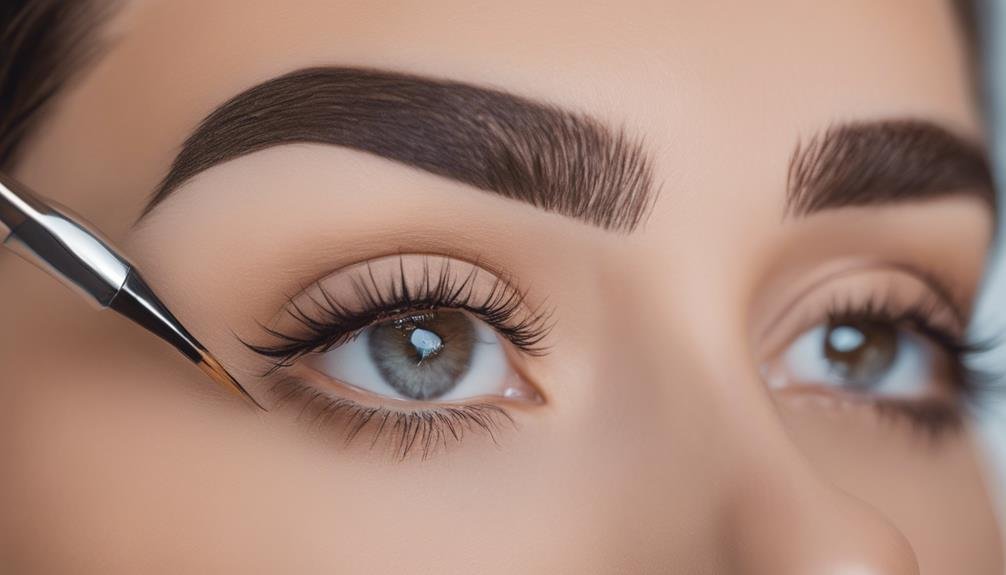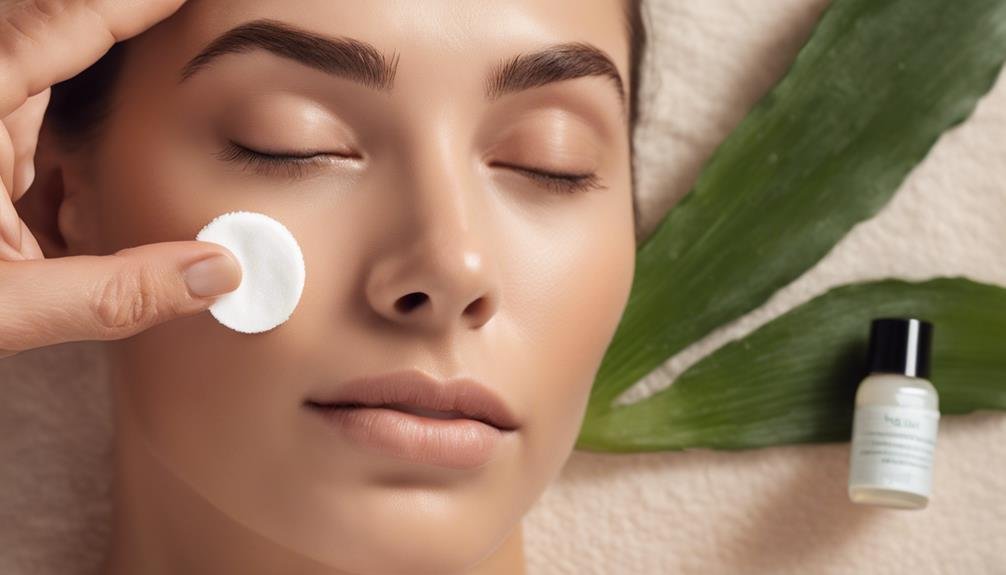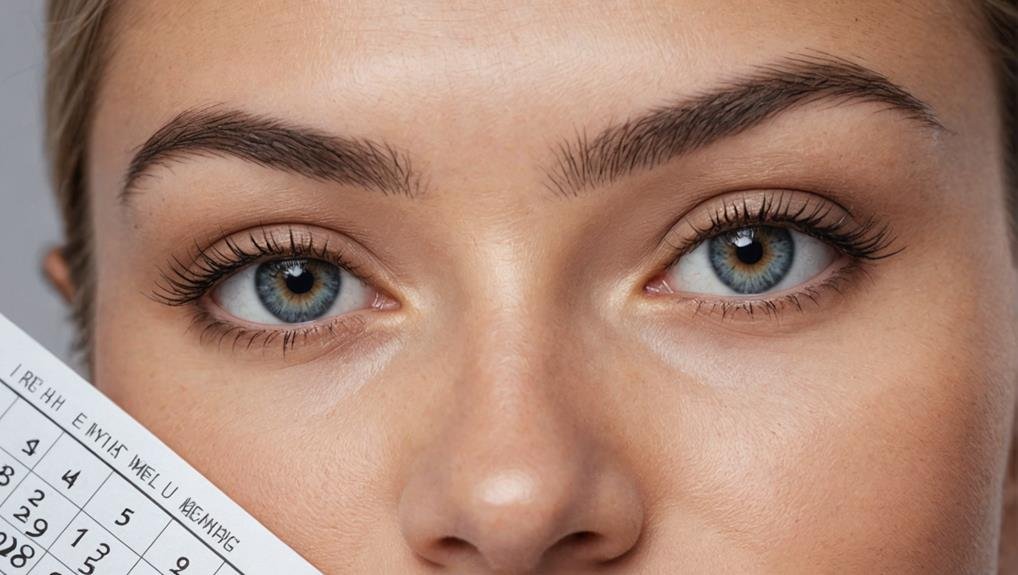When considering microblading, you probably wonder how long those perfectly shaped brows will last. It’s not just about the initial results; it’s also about maintaining them over time. You might be surprised to learn that factors such as your skin type and aftercare routine can greatly affect the longevity of your microblading. Oily skin, for instance, might cause faster fading. But don’t worry; there are ways to enhance the lifespan of your brows. Have you ever considered how age, hydration, or skincare routine might play into this? Let’s explore these intriguing aspects further.
Key Takeaways
- Microblading typically lasts between 18 months and a few years.
- Longevity is influenced by skin type, pigments used, and aftercare routines.
- Oily skin may cause faster fading, requiring more frequent touch-ups.
- Annual touch-ups are recommended to maintain desired results.
- Proper aftercare is crucial for vibrant and long-lasting microblading.
Microblading Duration Overview

Are you considering microblading for your brows? Understanding how long microblading lasts and what factors influence its duration is essential. Generally, microblading is a semi-permanent solution that lasts between 18 months and a few years. However, the longevity can vary based on several variables, including the pigments used, your skin type, and how well you adhere to aftercare instructions.
Different pigments have different lifespans; some may remain vibrant longer than others. While deeply implanted pigments can last indefinitely, touch-ups are usually necessary every 1-2 years to maintain the desired look. Skin types also play a critical role.
For instance, oily skin types might experience faster fading than drier skin types. Healing time is another factor that affects how long microblading lasts. Proper maintenance is crucial during this period. This includes protecting your brows from sun exposure and strictly following aftercare instructions.
Without proper care, you might notice premature fading or changes in pigment color. Significant fading or pigment changes can occur over time, typically after five years, necessitating additional touch-ups. By understanding these factors, you can better manage your expectations and maintain your brow appearance.
Skin Type Impact
Your skin type is important when considering microblading, as it affects how long the results will last. If you have normal to dry skin, you’ll likely enjoy more enduring results, while oily skin might lead to quicker pigment fading and a shadowing effect. For combination skin, expect touch-ups sooner, as different areas might respond differently.
Longevity on Dry Skin
For those with dry skin, microblading can offer impressive longevity due to better pigment retention. If you have normal to dry skin, you’ll find that the microblading healing process is smoother, and the Hair Strokes tend to expand less. This means you’ll achieve a more defined and longer-lasting Microblading look. It’s crucial to keep your skin well-hydrated, even if it’s dry, as proper skincare practices can enhance the durability of microblading.
Unlike oily or combination skin types, dry skin provides a more stable canvas, allowing the pigment to settle beautifully and remain consistent over time. As a result, microblading lasts longer, and you may require fewer touch-ups than those with oily skin. The contrast between Skin and Oily Skin is significant, as oilier skin can lead to quicker fading and less defined results.
Consider incorporating gentle moisturizers and hydrating products into your skincare routine to maximize the benefits. This supports the microblading process and guarantees your brows look their best for as long as possible. With dry, you are likely to enjoy a natural, lasting effect that highlights your features beautifully.
Oily Skin Challenges
Oily skin often poses unique challenges for microblading enthusiasts, primarily due to the high sebum levels affecting pigment adherence. When you have oily skin, your microblade brows might not retain their pigment as well as those of other skin types. This is because the excess oil, or sebum, can cause the pigment to fade faster. The strokes may expand more than expected, leading to an eyebrow enhancement that loses its crispness over time.
Maintaining the desired look often requires frequent touch-ups for those with oily skin. Unlike other skin types, where microblading results can last longer, your brows might need more regular visits to the salon to keep the pigment fresh.
A shadowing effect may also develop, making your brows look less defined as the pigment starts to spread under the skin.
Though microblading might not seem suitable for oily skin due to these challenges, it is not impossible to achieve beautiful results. By understanding the impact of high sebum levels and planning for more frequent touch-ups, you can manage the faster fading and keep your microblade brows looking their best.
Combination Skin Considerations
Managing microblading with combination skin involves understanding the unique challenges posed by varying oiliness and dryness across different areas of your face. With combination skin types, the T-zone is typically oilier, leading to quicker fading of the microblading pigment than drier areas. This means that you might notice the pigment fading more rapidly in these oily areas, requiring touch-ups sooner than you would with other skin types. Touch-ups are essential for maintaining the desired look and ensuring the longevity of your microblading.
Your skincare routine plays a significant role in the success of microblading. It’s vital to adhere to aftercare instructions meticulously.
For combination skin, this might mean adjusting your routine to accommodate both the oily and dry parts of your face. Use products that will not increase oiliness or dryness. This balance can help maintain the pigment longer.
Maintenance and Touch-Ups

Maintaining the fresh appearance of your microblading requires regular attention and timely touch-ups. Microblading results typically last between 18 and 30 months, but maintaining these outcomes means monitoring fading and being prepared for annual maintenance. Touch-ups are essential for keeping your permanent makeup looking its best, as they replenish the pigment that fades over time.
If you have oily skin, you might notice the happenings a bit faster, meaning you likely need more frequent touch-ups to keep your brows looking sharp.
Regular touch-ups, ideally once or twice a year, prevent the need for a complete redo of the procedure. Waiting too long can result in the pigment fading to the point where your microblading no longer enhances your appearance, requiring a more extensive appointment to restore the desired look.
In this way, staying on top of these sessions guarantees your brows maintain their shape and color, providing lasting results you can enjoy.
Factors Affecting Longevity
Several factors significantly impact how long your microblading results will last. Skin age is a key player; younger skin often retains pigment better due to its higher elasticity and faster healing process. On the other hand, older skin may struggle with pigment retention, leading to shorter-lasting results.
Your sskin’shydration levels also play a vital role. Well-moisturized skin tends to hold onto pigment more effectively, so staying hydrated can prolong the life of your microblading.
Good nutritional status supports overall skin health and can influence how well your skin retains pigment. A balanced diet rich in vitamins and minerals helps maintain healthy skin, which can extend the results of your microblading.
Compliance with aftercare instructions is essential for optimal healing. Following these guidelines ensures that your skin heals properly, reducing the risk of premature fading.
Smoking is another factor that can negatively impact the longevity of your microblading. It can hinder the healing process and accelerate the fading of pigments. By being aware of these factors and making necessary lifestyle adjustments, you can maximize the lifespan of your microblading and enjoy beautiful results for longer.
Aftercare Best Practices

Proper aftercare is necessary to ensure the longevity of your microblading results. To start, avoid exposing your brows to excessive moisture. Activities like swimming in salt water or chlorinated pools can lead to premature fading, so avoiding them during the healing process is best.
Keeping your eyebrows dry for the first few days is essential for ideal healing and pigment retention.
Sunlight is another factor that can impact your microblading results. Direct exposure can cause the pigment to fade quickly, so apply sunscreen on your brows once the initial healing phase is over. This simple step helps maintain your desired look for a longer duration.
Avoid harsh exfoliants or products with glycolic acid on your eyebrows when it comes to skincare. These can strip away the pigment and affect longevity. Instead, focus on gentle cleansing methods to protect your investment.
Long-Term Results
Understanding how long they last is crucial to enjoying your microblading results for the long haul. The microblading procedure can last anywhere from 18 months to a few years, depending on several factors. Deeply implanted pigment may remain indefinitely, but you might notice significant fading or pigment changes after about five years. Touch-ups are needed every 1-2 years to maintain the desired look.
Different skin types are vital in determining the longevity of your microblading. Oily skin can cause pigments to fade quickly, while drier skin types might retain color longer. Similarly, the choice of pigments affects longevity. Some colors last longer than others, so discussing options with your technician is important.
Proper maintenance is crucial for long-term results. Protecting your brows from sun exposure and following aftercare instructions will help preserve the pigment. This may include avoiding certain skincare products and ensuring your brows stay moisturized.
Enhancing Microblading Lifespan

Focus on adopting a diligent and tailored aftercare routine to enhance the lifespan of your microblading consistently. Proper care is essential for ensuring your new brow shape remains vibrant and natural for as long as possible. Various factors, including skin type, pigment choice, and sun exposure, can affect how long microblading lasts. You might enjoy slightly longer-lasting results due to slower cell turnover if you have normal or dry skin. However, to maximize longevity, you must protect the surface of your brows from damaging elements. Here, you can keep your microblading looking fresh:
- Avoid direct sunlight: Prolonged sun exposure can cause fading. Wear a hat or use sunscreen on your brows to shield them.
- Skip harsh skincare products: Certain ingredients,, like retinoids,, can break down the pigment, leading to temporary fading.
- Schedule regular touch-ups: These help maintain the depth of color and definition, ensuring your brows are long.
- Moisturize carefully: Keep the area hydrated to promote healing, but avoid over-moisturizing, which might impact pigment retention.
Adhering to these practices helps combat fading and pigment changes, keeping your microbladed brows beautiful and well-defined for years.
Conclusion
To sum up, the longevity of your microblading results depends on several factors. Your skin type plays a significant role, with oily skin often experiencing quicker fading. To guarantee lasting results, adhere to aftercare instructions and schedule regular touch-ups. Your skincare routine, hydration levels, and skin age will also impact how long the pigments last. By following these practices, you can enhance the lifespan of your microblading and enjoy beautiful results for longer.
FAQs
How long does microblading typically last?
Microblading typically lasts 12 to 24 months, depending on factors like skin type, lifestyle, and aftercare. As a semi-permanent cosmetic treatment, the pigment fades over time due to the natural cell turnover in the skin. After the initial procedure, many people opt for a touch-up around 6-8 weeks to perfect the look, and yearly touch-ups are recommended to maintain the color and shape.
Key Duration:
- Lasts 12 to 24 months.
- Initial touch-up needed after 6-8 weeks.
- Annual touch-ups are recommended.
What factors affect how long microblading lasts?
Several factors influence how long your microblading results last:
- Skin Type: Oily skin tends to break down the pigment faster, leading to quicker fading, while dry skin may hold onto the pigment longer.
- Sun Exposure: UV rays can cause the pigment to fade more quickly, so protecting your brows from sun exposure by wearing sunscreen or a hat can help extend the results.
- Skincare Routine: Exfoliating products, retinol, or acids near the eyebrow area can cause the pigment to fade faster due to increased cell turnover.
- Lifestyle: Frequent swimming, especially in chlorinated pools, or exposure to saltwater can also accelerate the fading process.
Factors Influencing Longevity:
- Skin type (oily skin fades faster).
- Sun exposure (UV rays can lighten pigment).
- Skincare products (exfoliants speed up fading).
- Lifestyle (swimming or excessive sweating).
How can I make my microblading last longer?
To prolong the results of your microblading, follow these aftercare tips:
- Avoid Water and Sweat: For the first 10-14 days after the procedure, avoid getting your brows wet and steer clear of activities that cause excessive sweating.
- Use Sunscreen: Apply sunscreen to your brows regularly to protect the pigment from UV damage, especially outdoors.
- Avoid Exfoliating Products: Keep products like retinoids, alpha hydroxy acids (AHA), and beta hydroxy acids (BHA) away from your brow area, as these can fade the pigment faster.
- Touch-Ups: Schedule annual touch-ups to refresh the color and shape as the pigment fades.
Prolonging Tips:
- Avoid water, sweat, and sun exposure initially.
- Apply sunscreen to the brows.
- Avoid exfoliants near your brows.
- Schedule annual touch-ups.
Does microblading fade completely over time?
Yes, microblading gradually fades over time and can disappear completely after 12 to 24 months if not maintained with touch-ups. The pigment used in microblading is semi-permanent, and unlike tattoo ink, it is designed to fade naturally as the skin regenerates. Without annual touch-ups, your brows may eventually return to their natural appearance.
Fading Process:
- Gradual fading over 12 to 24 months.
- It can fade completely without touch-ups.
- Semi-permanent, unlike permanent tattoos.
How often do I need touch-ups to maintain microblading?
A touch-up is recommended about once a year to maintain the shape, color, and fullness of your microbladed eyebrows. For the best results:
- Initial Touch-Up: After the first session, you’ll need a follow-up touch-up within 6-8 weeks to perfect the shape and color.
- Annual Touch-Ups: After the initial touch-up, a yearly session is ideal to refresh the pigment as it gradually fades.
Touch-Up Frequency:
- Initial touch-up 6-8 weeks after the first session.
- Yearly touch-ups to maintain color and shape.

